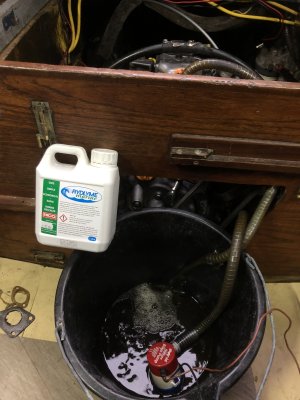UK-WOOZY
Well-known member
renewed the exhaust elbow and thermostat over the weekend. noted salt deposits by the thermostat where the hose attached, the hoses were pretty clear but replaced those. looking into the engine i saw it looked quite scaled up inside the engine so could do with a flush. looking at getting proflush -
Proflush - Marine Engine Descaler - Wessex Chemical Factors
i have read some say to remove the thermostat and some say to leave in situe, remove the anodes too of course. i plan to have two buckets, one with a hose to the raw water pump and the other end from the thermostat housing which usually connects to the elbow then a pump to pump between the buckets to circulate the fluid? Or suck the fluid into the engine and leave then flush out? Unsure which to do or how to go about it properly as theres conflicting advice online as usual.
to note the thermostat opens fine in hot water and closed fine when put back in cold, the same for a spare i have too.
Also how much cleaning fluid do people reccomend?
thank you
Proflush - Marine Engine Descaler - Wessex Chemical Factors
i have read some say to remove the thermostat and some say to leave in situe, remove the anodes too of course. i plan to have two buckets, one with a hose to the raw water pump and the other end from the thermostat housing which usually connects to the elbow then a pump to pump between the buckets to circulate the fluid? Or suck the fluid into the engine and leave then flush out? Unsure which to do or how to go about it properly as theres conflicting advice online as usual.
to note the thermostat opens fine in hot water and closed fine when put back in cold, the same for a spare i have too.
Also how much cleaning fluid do people reccomend?
thank you

